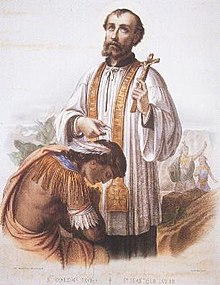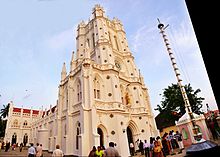Latin Catholics of Malabar: Difference between revisions
Micahhadar (talk | contribs) Some sources. Tags: Visual edit Mobile edit Mobile web edit |
Micahhadar (talk | contribs) →Socio-cultural and religious identity: Differentiated headlines for content to be added further. Tags: Mobile edit Mobile web edit |
||
| Line 35: | Line 35: | ||
The Latin Catholics of Kerala are a highly [[Exogamy|exogamous]] community and tend to intermarry with other [[Hindus|Hindu]] [[Caste|castes]] unlike the [[Saint Thomas Christians|Saint Thomas Syrian Christians]] who practice strict [[endogamy]]<ref>{{Cite web|title=For Latin Catholic Church, community matters more than issues|url=https://www.newindianexpress.com/states/kerala/2021/apr/01/for-latin-catholic-church-community-matters-more-than-issues-2284140.html|access-date=2021-06-11|website=The New Indian Express}}</ref><ref>{{Cite web|title=Why Christo-Racist Nationalism and Anti-Muslim Rhetoric Are Gaining Ground in Kerala|url=https://thewire.in/religion/kerala-syrian-christians-caste-anti-muslim-rhetoric|access-date=2021-06-11|website=thewire.in|language=en}}</ref>. |
The Latin Catholics of Kerala are a highly [[Exogamy|exogamous]] community and tend to intermarry with other [[Hindus|Hindu]] [[Caste|castes]] unlike the [[Saint Thomas Christians|Saint Thomas Syrian Christians]] who practice strict [[endogamy]]<ref>{{Cite web|title=For Latin Catholic Church, community matters more than issues|url=https://www.newindianexpress.com/states/kerala/2021/apr/01/for-latin-catholic-church-community-matters-more-than-issues-2284140.html|access-date=2021-06-11|website=The New Indian Express}}</ref><ref>{{Cite web|title=Why Christo-Racist Nationalism and Anti-Muslim Rhetoric Are Gaining Ground in Kerala|url=https://thewire.in/religion/kerala-syrian-christians-caste-anti-muslim-rhetoric|access-date=2021-06-11|website=thewire.in|language=en}}</ref>. |
||
==Culture== |
|||
===Arts=== |
|||
===Attire=== |
|||
===Religion and Ritual=== |
|||
===Cuisine=== |
|||
==Demographics== |
==Demographics== |
||
Revision as of 13:51, 20 June 2021

The Latin Catholics of Malabar Coast, also known as Roman Catholics of Kerala or Malabar Latin Catholics, are a multi-ethnic religious group who constitute the ecclesiastical provinces of Verapoly and Trivandrum, which follow the Roman Rite of the Latin Church, on the Malabar Coast, the southwestern coast of India.[1] They are predominantly Malayali people and speak the Malayalam language. They trace their origins to the evangelisation of Malabar Coast by the Dominican, Franciscan, Jesuit and Carmelite missionaries, mainly French and Portuguese.[2][3]
History
Early missions

The Roman Catholic Church in India has origins that trace to the Fransciscan missions which were sent to Asia in the leadership of John of Monte Corvino. Friar Odoric of Pordenone arrived in India in 1321. He visited Malabar, touching at Pandarani (Koyilandy) (20 m. north of Calicut), at Cranganore, and at Quilon (Kollam) proceeding thence, apparently, to Ceylon and to the shrine of Apostle Saint Thomas at Mylapur near Madras. He writes he had found the place where Saint Thomas was buried.
Father Jordanus Catalani, a French Dominican missionary, followed in 1321–22. He reported to Rome, apparently from somewhere on the west coast of India, that he had given Christian burial to four martyred monks. Jordanus is known for his 1329 Mirabilia describing the marvels of the East. He furnished the best account of Indian regions and the Christians, the products, climate, manners, customs, fauna and flora given by any European in the Middle Ages – superior even to Marco Polo's.
The Diocese of Quilon headquartered at Kollam is the first Roman Catholic diocese in South Asia and the Far East, having been first erected on 9 August 1329 and re-erected on 1 September 1886. In 1329 Pope John XXII (in captivity at Avignon) erected Quilon as the first Diocese in the whole Indies as suffragan to the Archdiocese of Sultany in Persia. Its territorial jurisdiction extended throughout the Indian subcontinent, East Indies, and the Far East.[4] By a separate Bull "Venerabili Fratri Jordano", the same Pope, on 21 August 1329 appointed the French Dominican friar Jordanus Catalani de Severac as the first Bishop of Quilon. In 1347, Giovanni de Marignolli visited the shrine of Saint Thomas near the modern Madras, and then proceeded to what he calls the kingdom of Saba, and identifies with the Sheba of Scripture, but which seems from various particulars to have been Java. Taking ship again for Malabar on his way to Europe, he encountered great storms.
Arrival of the Portuguese

In 1453, the fall of Constantinople, a bastion of Christianity in Asia Minor to Islamic Ottoman Empire, marked the end of the Eastern Roman Empire or Byzantine Empire, and severed European trade links by land with Asia. This massive blow to Christendom spurred the age of discovery as Europeans were seeking alternative routes east by sea along with the goal of forging alliances with pre-existing Christian nations.[5][6] Along with pioneer Portuguese long-distance maritime travellers, that reached the Malabar Coast in the late 15th century, came Portuguese missionaries who introduced the Latin Catholic church in India. They made contact with the St Thomas Christians in Kerala, which at that time were following Eastern Christian practices and were under the jurisdiction of Church of the East.

The history of Portuguese missionaries in India starts with the neo-apostles who reached Kappad near Kozhikode on 20 May 1498 along with the Portuguese explorer Vasco da Gama who was seeking to form anti-Islamic alliances with pre-existing Christian nations.[7] [8] The lucrative spice trade was further temptation for the Portuguese crown.[9] When he and the Portuguese missionaries arrived they found no Christians in the country, except in Malabar known as St. Thomas Christians who represented less than 2% of the total population[10] and the then-largest Christian church within India.[7] The Christians were friendly to Portuguese missionaries at first; there was an exchange of gifts between them, and these groups were delighted at their common faith.[11]

During the second expedition, the Portuguese fleet comprising 13 ships and 18 priests, under Captain Pedro Álvares Cabral, anchored at Cochin on 26 November 1500. Cabral soon won the goodwill of the Raja of Cochin. He allowed four priests to do apostolic work among the early Christian communities scattered in and around Cochin. Thus Portuguese missionaries established Portuguese Mission in 1500. Dom Francisco de Almeida, the first Portuguese Viceroy, got permission from the Kochi Raja to build two church edifices – namely Santa Cruz Basilica (founded 1505) and St. Francis Church (founded 1506) using stones and mortar which was unheard of at that time as the local prejudices were against such a structure for any purpose other than a royal palace or a temple.
Socio-cultural and religious identity

The Latin Catholics of Kerala form a multi-ethnic religious community with members of different castes and origins. Majority of the Latin Catholics were converts by the Portuguese Roman Catholic missionaries in India[12][13][14]. Many lower castes like Parayars, Pulayars, Ezhavars, Thiyyar, Nadars, lower castes among the Nairs along with the various fishing community castes like Mukkuvars, Arayans, Valans and Dheevars were converted to Christianity after the 16th century by Portuguese missionaries in Malabar[15][16]. Most of the lower castes and untouchables converted to Christianity to get rid of the low caste status, but the new converts were not allowed to join the upper caste Saint Thomas Syrian Christians and were treated the same even after[17][18]. Many Saint Thomas Syrian Christian families also joined the Latin Church, especially in Cochin and Quilon. The Luso-Indian community, who have Portuguese ancestory also forms part of the Latin Catholics of Kerala.
The Portuguese had intermarried within the natives and their descendants came to be known as the Munnuttikkar (Luso-Indians) who form an endogamous subgroup among the Keralite Latin Catholics[19][20].
Another subgroup known as Ezhunoottikkar hailed from the various castes like Ezhavas, Thiyyas and the lower subcastes of Nairs. The lower strata of the Ezhunoottikkar consists of the untouchable castes like Pulayar, Parayar and Nadar[21]. The Nadar Christians differentiates themselves from the rest of the Ezhunoottikkar with frequent marriages with the Hindu Nadars[22].

The Anjuttikkar consists of the various fishing communities like Mukkuvars, Dheevars, Valans and Arayans, who were differentiated from the other groups. The Anjuttikkar (fishing community) forms 45% of the Latin Catholic community of Kerala. Mainly focused in the coastal regions of Thiruvananthapuram, Kollam and Alappuzha districts.[23][24].
The Roman or Latin Catholics of Kerala are grouped under Other Backward Classes by positive discrimination[25][26].
The Latin Catholics of Kerala are a highly exogamous community and tend to intermarry with other Hindu castes unlike the Saint Thomas Syrian Christians who practice strict endogamy[27][28].
Culture
Arts
Attire
Religion and Ritual
Cuisine
Demographics

The Latin Catholics of Kerala form 13.2% of the Christians in the state. They form 2.37% of the total population of Kerala[29]. The community is concentrated in the coastal regions of Thiruvananthapuram, Kollam, Alappuzha and Ernakulam districts. They form 78% of the Christians in the Thiruvananthapuram district, 36% of the Christians in the Kollam district and 8% of the Christians in the Ernakulam district. They have significant populations in Trivandrum, Alleppey, Neyyantinkara, Parassala, Punalur, Quilon, Verapoly, Vypeen, Calicut, Cannanore and Cochin.
References
- ^ Thayil, Thomas (2003). The Latin Christians of Kerala: A Study on Their Origins. Kristu Jyoti Publications. ISBN 978-81-87370-18-5.
- ^ Britannica CD 97, S.V "Gama, Vasco da "
- ^ Vasco da Gama collection on University of Michigan Archived 16 October 2007 at the Wayback Machine
- ^ "Romanus Pontifix” dated 9 th August 1329 Pope John XXII
- ^ "Byzantine-Ottoman Wars: Fall of Constantinople and spurring "age of discovery"". Retrieved 18 August 2012.
- ^ "Overview of Age of Exploration". Archived from the original on 9 July 2012. Retrieved 18 August 2012.
- ^ a b Factfile: Catholics around the world on BBC news.
- ^ Britannica CD 97, S.V "Gama, Vasco da "
- ^ Vasco da Gama collection on University of Michigan Archived 16 October 2007 at the Wayback Machine
- ^ Megan Galbraith Catholic Church of India Responds with Leadership Field note on Glocal Health Council website. Archived 3 March 2008 at the Wayback Machine
- ^ Mathias Mundadan, (1967), "The Arrival of Portuguese in India and Saint Thomas Christians under Mar Jacob"
- ^ Koilparampil, George (1982). Caste in the Catholic Community in Kerala: A Study of Caste Elements in the Inter Rite Relationships of Syrians and Latins. Department of Sociology, St. Teresa's College.
- ^ Visvanathan, Susan (1993). The Christians of Kerala: History, Belief, and Ritual Among the Yakoba. Oxford University Press. ISBN 978-0-19-563189-0.
- ^ "Neyyatinkara: The fertile ground of sub-castes". The New Indian Express. Retrieved 2021-06-20.
- ^ Bayly, Susan (2004-04-22). Saints, Goddesses and Kings: Muslims and Christians in South Indian Society, 1700–1900. Cambridge University Press. ISBN 978-0-521-89103-5.
- ^ "Neyyatinkara: The fertile ground of sub-castes". The New Indian Express. Retrieved 2021-06-20.
- ^ Thomas, Sonja (2020-12-30), "Syrian Christians and dominant-caste Hindus", The Routledge Handbook of Hindu–Christian Relations, Abingdon, Oxon; New York: Routledge, 2021.: Routledge, pp. 69–78, ISBN 978-1-003-13984-3, retrieved 2021-06-17
{{citation}}: CS1 maint: location (link) - ^ "Why Christo-Racist Nationalism and Anti-Muslim Rhetoric Are Gaining Ground in Kerala". thewire.in. Retrieved 2021-06-17.
- ^ "HISTORY OF CHRISTIANITY IN INDIA (CORRECTED).pdf ..." pdfkul.com. Retrieved 2021-06-19.
- ^ "Neyyatinkara: The fertile ground of sub-castes". The New Indian Express. Retrieved 2021-06-20.
- ^ "HISTORY OF CHRISTIANITY IN INDIA (CORRECTED).pdf ..." pdfkul.com. Retrieved 2021-06-19.
- ^ "Neyyatinkara: The fertile ground of sub-castes". The New Indian Express. Retrieved 2021-06-20.
- ^ "HISTORY OF CHRISTIANITY IN INDIA (CORRECTED).pdf ..." pdfkul.com. Retrieved 2021-06-19.
- ^ "Neyyatinkara: The fertile ground of sub-castes". The New Indian Express. Retrieved 2021-06-20.
- ^ Sudhi, K. s (2021-03-25). "Kerala has 164 forward caste communities". The Hindu. ISSN 0971-751X. Retrieved 2021-06-11.
- ^ "Neyyatinkara: The fertile ground of sub-castes". The New Indian Express. Retrieved 2021-06-20.
- ^ "For Latin Catholic Church, community matters more than issues". The New Indian Express. Retrieved 2021-06-11.
- ^ "Why Christo-Racist Nationalism and Anti-Muslim Rhetoric Are Gaining Ground in Kerala". thewire.in. Retrieved 2021-06-11.
- ^ K.C. Zachariah (April 2016). "Religious Denominations of Kerala" (PDF). Center for Development Studies. Retrieved 8 July 2018.
